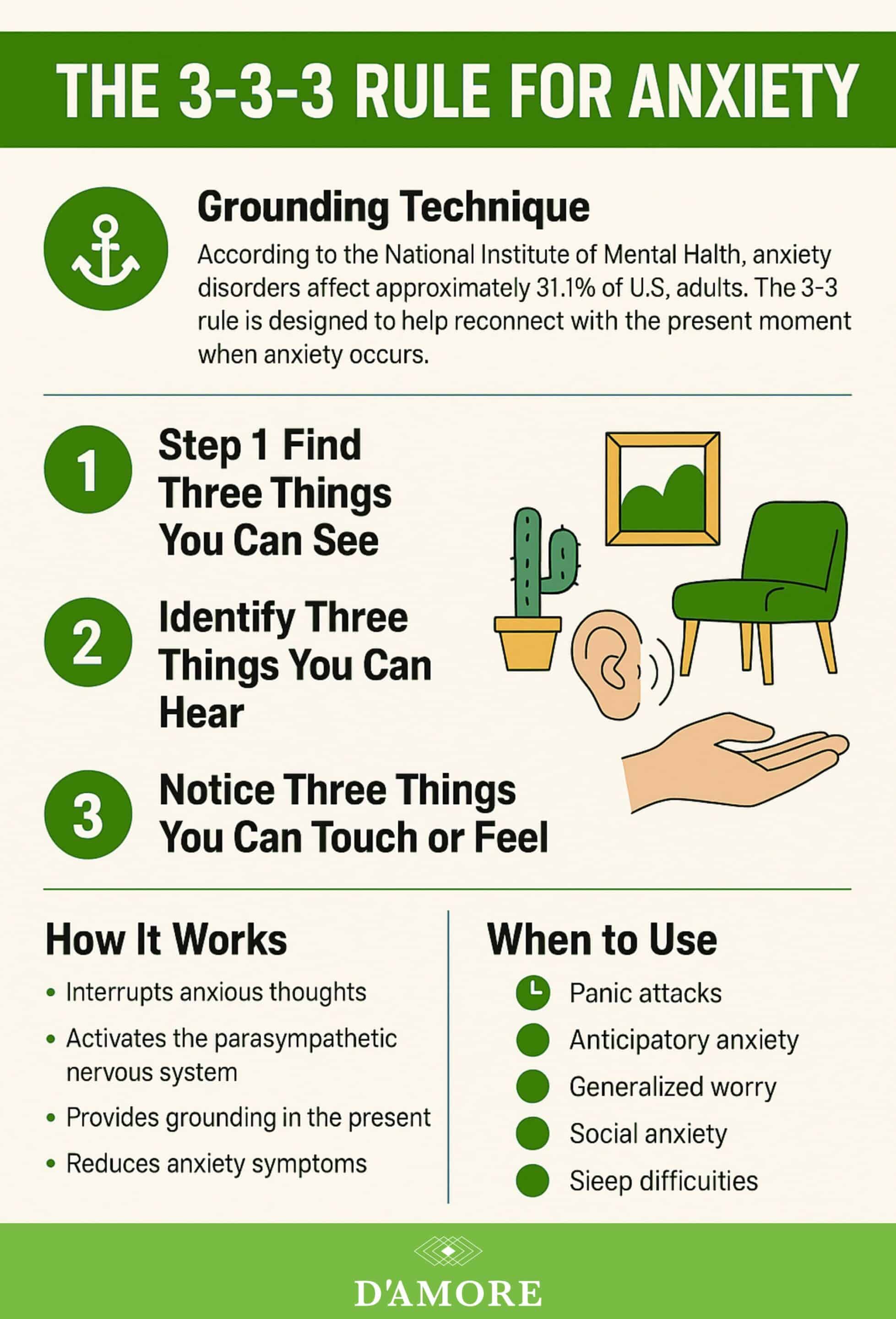When anxiety strikes, it can feel overwhelming and all-consuming. Your heart races, your thoughts spiral, and you may feel disconnected from your surroundings. In these moments, having a simple, accessible tool can make all the difference. The 3-3-3 rule for anxiety is a powerful grounding technique that can help you regain control and find calm in the midst of anxious feelings.
Understanding the 3-3-3 Rule
The 3-3-3 rule is a mindfulness-based grounding technique designed to help you reconnect with the present moment when anxiety takes hold. This simple yet effective strategy engages your senses to pull you out of anxious thoughts and back into your immediate environment. According to the National Institute of Mental Health, anxiety disorders affect approximately 31.1% of U.S. adults at some point in their lives, making accessible coping strategies like the 3-3-3 rule particularly valuable.
The rule is straightforward:
- 3 things you can see – Look around and identify three specific objects in your environment
- 3 things you can hear – Listen carefully and name three distinct sounds around you
- 3 things you can touch or feel – Focus on three physical sensations or textures you can experience
How the 3-3-3 Rule Works
Grounding Through Sensory Engagement
When anxiety activates your body’s fight-or-flight response, your mind often becomes consumed with worry about future events or past experiences. The 3-3-3 rule redirects your attention to the present moment by engaging your senses systematically.
This technique works by:
- Interrupting anxious thought patterns
- Activating your parasympathetic nervous system
- Providing immediate grounding in the present moment
- Giving your mind a concrete task to focus on
- Reducing the intensity of physical anxiety symptoms
The Science Behind Grounding Techniques
Research shows that grounding techniques like the 3-3-3 rule can effectively reduce anxiety symptoms by activating the body’s relaxation response. When you focus on sensory input from your environment, you signal to your nervous system that you are safe in the present moment, helping to deactivate the stress response. Studies have found that mindfulness-based interventions significantly reduce anxiety symptoms and promote parasympathetic nervous system activation, which helps the body return to a calm, regulated state.
Step-by-Step Guide to Using the 3-3-3 Rule
Step 1: Find Three Things You Can See
Take a moment to look around your environment. Choose three specific objects and really focus on them. Instead of simply noting “chair,” try to be more descriptive: “the blue fabric chair with wooden legs” or “the small cactus plant in the terracotta pot.” This detailed observation helps anchor your attention more effectively.
Step 2: Identify Three Things You Can Hear
Close your eyes or soften your gaze and listen carefully to your surroundings. You might hear:
- The hum of an air conditioner
- Birds chirping outside
- The distant sound of traffic
- Your own breathing
- The ticking of a clock
Focus on each sound individually, allowing it to fully register in your awareness.
Step 3: Notice Three Things You Can Touch or Feel
This step involves physical sensations and textures. You might:
- Feel the texture of your clothing against your skin
- Notice the temperature of the air on your face
- Touch the surface of a table or wall
- Feel your feet on the ground
- Experience the sensation of your hands resting in your lap
When to Use the 3-3-3 Rule
The 3-3-3 rule is particularly effective during:
- Panic attacks – When overwhelming anxiety symptoms arise suddenly
- Anticipatory anxiety – Before stressful events or situations
- Generalized worry – When your mind is racing with anxious thoughts
- Social anxiety – In uncomfortable social situations (learn more about social anxiety treatment)
- Sleep difficulties – When anxiety interferes with falling asleep
Enhancing the 3-3-3 Rule
Breathing Integration
Combine the 3-3-3 rule with deep breathing exercises. Take slow, deep breaths between each step, inhaling through your nose and exhaling through your mouth. This combination can enhance the calming effect.
Mindful Movement
If you’re able to move around, consider incorporating gentle movement with the 3-3-3 rule. Walking slowly while engaging your senses can be particularly grounding.
Personalization
Adapt the technique to your preferences. Some people find it helpful to say the observations out loud, while others prefer to note them silently. Find what works best for you.
Additional Grounding Techniques
While the 3-3-3 rule is highly effective, having multiple tools in your anxiety management toolkit can be beneficial:
The 5-4-3-2-1 Technique
This expanded version involves:
- 5 things you can see
- 4 things you can touch
- 3 things you can hear
- 2 things you can smell
- 1 thing you can taste
Progressive Muscle Relaxation
Systematically tense and release different muscle groups throughout your body to promote physical relaxation.
Visualization
Imagine yourself in a calm, peaceful place where you feel safe and relaxed.
Building Long-Term Anxiety Management Skills
While the 3-3-3 rule provides immediate relief, developing comprehensive anxiety management skills often requires professional support. According to the World Health Organization, anxiety disorders are the most common mental health conditions globally, affecting 301 million people worldwide. Effective long-term strategies may include:
Cognitive Behavioral Therapy (CBT)
CBT helps identify and change negative thought patterns that contribute to anxiety. This evidence-based approach teaches practical skills for managing anxious thoughts and behaviors.
Dialectical Behavior Therapy (DBT)
DBT combines mindfulness practices with emotional regulation skills, distress tolerance techniques, and interpersonal effectiveness training.
Medication Management
For some individuals, anti-anxiety medications or antidepressants may be helpful as part of a comprehensive treatment plan.
Lifestyle Modifications
Regular exercise, adequate sleep, balanced nutrition, and stress management techniques can significantly impact anxiety levels.
When to Seek Professional Help
While self-help techniques like the 3-3-3 rule can be incredibly valuable, some situations warrant professional intervention. The Anxiety and Depression Association of America reports that anxiety disorders affect 31.9% of adolescents and are frequently associated with other mental health conditions. Consider seeking professional help when:
- Anxiety significantly interferes with daily activities
- Panic attacks occur frequently
- Avoidance behaviors limit your life experiences
- Physical symptoms of anxiety persist
- Anxiety coexists with depression or other mental health conditions
- Self-medication with alcohol or substances becomes a concern
The 3-3-3 Rule in Daily Life
Workplace Applications
The 3-3-3 rule can be discreetly used in professional settings:
- During stressful meetings
- Before important presentations
- When dealing with difficult conversations
- During overwhelming workday moments
Educational Settings
Students can benefit from this technique:
- Before exams or tests
- During social situations at school
- When feeling overwhelmed by academic pressure
- In new or unfamiliar environments
Social Situations
The rule can provide support during:
- Social gatherings or parties
- Public speaking opportunities
- Dating or relationship stress
- Family gatherings or events
Creating Your Personal Anxiety Management Plan
Developing a comprehensive approach to anxiety management involves:
- Learning multiple techniques – Don’t rely on just one strategy
- Practicing regularly – Use grounding techniques when you’re calm to build familiarity
- Identifying triggers – Understanding what situations tend to increase your anxiety
- Building support systems – Connecting with friends, family, or support groups
- Seeking professional guidance – Working with mental health professionals when needed
The Power of Present-Moment Awareness
The 3-3-3 rule exemplifies the power of present-moment awareness in anxiety management. By training yourself to return to the here and now, you develop resilience against anxious thoughts and feelings. This skill becomes stronger with practice, making it easier to access during times of stress. Research from the University of Rochester Medical Center confirms that sensory-based grounding techniques like the 3-3-3 rule can be effective tools for managing anxiety and overwhelming emotions.
Remember that managing anxiety is a journey, not a destination. Be patient with yourself as you learn and practice new techniques. What works for one person may not work for another, so it’s important to explore different strategies and find what resonates with you. For additional support, consider reading about stress vs. anxiety to better understand your experiences. The National Institute of Mental Health provides comprehensive resources about anxiety disorders and evidence-based treatment approaches.
Take the Next Step in Your Mental Health Journey
If you’re struggling with anxiety and finding that self-help techniques aren’t providing sufficient relief, you don’t have to face these challenges alone. At D’Amore Mental Health, we specialize in comprehensive anxiety treatment that combines evidence-based therapies with personalized care.
Our experienced team offers various levels of care, including our Intensive Outpatient Program (IOP) and Partial Hospitalization Program (PHP), designed to provide structured support while allowing you to maintain your daily responsibilities. We utilize proven approaches like Cognitive Behavioral Therapy, Dialectical Behavior Therapy, and mindfulness-based interventions to help you develop lasting anxiety management skills.
Located in Orange County, California, D’Amore Mental Health is in-network with many major insurance providers, making quality mental health care accessible when you need it most. Our compassionate approach emphasizes building your confidence and independence while providing the professional support necessary for meaningful recovery. Learn more about our approach to mental health treatment.
Don’t let anxiety control your life any longer. Contact D’Amore Mental Health today at (714) 868-7593 to learn more about our anxiety treatment programs and take the first step toward a calmer, more confident future. You can also verify your insurance to understand your coverage options.






































